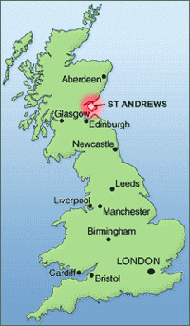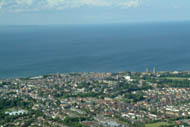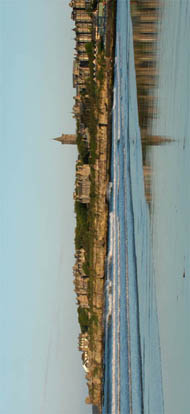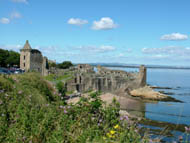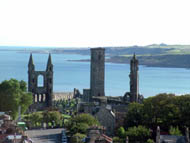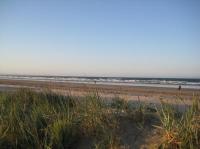The University of St Andrews is both an ancient seat of learning and one of Britain's most forward-looking institutions. In a small town, shared between "academics, students and golfers ", located on the East coast of Scotland, north of Edinburgh, St Andrews provides a quiet and outstanding environment for research and study.
We are located at the School of Physics and Astronomy which is a member of the Scottish Universities Physics Alliance (SUPA) and committed to ensuring that their research activity competes at the highest international level. Current areas of research include optoelectronics, magnetism, photonic crystals, optical tweezers, catalysis, ionic liquids, molecular electronic, etc, which are among the wide range of scientific research actively pursued at St Andrews and stimulated by numerous local and international collaborations between physicists, chemists and biologists.
The University of St Andrews - Scotland’s first University
History and Excellence
The University of St Andrews is Scotland’s top rated research institution and one of the leading research-intensive universities in the world. As an ancient seat of learning, the University, founded in 1413, has enjoyed a high reputation for teaching, scholarship and research for almost six centuries. St Andrews attracts outstanding scholars from around the world who continually enhance the reputation of this academic gem by conducting ground breaking research across all disciplines. Within the Faculty of Science, this includes Physics , Chemistry , Biology , Mathematics and Computer Sciences .
The University demonstrated its excellence in the most recent UK wide Research Assessment Exercise (RAE). The RAE is the UK Government procedure conducted every 5-7 years for producing ranking and benchmarking of research quality in all UK Universities by grading from 1 to 5* according to research outputs and other key research performance indicators. St Andrews achieved the best result in Scotland with every subject area in the University achieving international status in research confirming that within St Andrews resides one of the most productive and stimulating science environments in the UK.
| The University continues to maintain an enviable reputation for success in teaching as demonstrated by its position in the most important University guides including the Sunday Times UK University Guide, the Guardian University Guide, the Times Good University Guide, as well as the National Student Survey which measured student satisfaction with teaching and resources at their university. St Andrews students rated themselves as the top mainstream university in the UK. St Andrews is a charming mediaeval town located in a spectacular coastal setting steeped in history with a breadth of student associations and societies , a dynamic and interactive community , excellent facilities and easy access to the mountains for hill-walking and if not skiing for the most impetuous. The St Andrews Old Course is famous as the world’s very first golf course. Fine hotels and gourmet restaurants are plentiful in and around the town. |
|
| The University of St Andrews is an enthusiastic supporter of the Scottish Funding Council (SFC) strategy of developing research pooling and excellence across Scottish HEIs and has taken a leading role in the development of this innovative concept. St Andrews has taken a leading role in the development of the Scottish Universities Physics Alliance (SUPA) including the Universities of Edinburgh, Glasgow, Heriot-Watt, Paisley, St Andrews, Strathclyde, and the joint Chemistry Research School of Edinburgh and St. Andrews (EaStCHEM). SUPA has a coherent approach to staffing strategy, research training, research initiatives and funding opportunities. This pooling creates the largest group of Physics researchers in the UK and provides a single ‘front door’ for potential staff, sponsors, and industrial collaborators. EaStCHEM is the premier Chemistry research school for Chemistry in Scotland and one of the largest in the UK, with around 500 researchers working on both core and interdisciplinary chemistry. The aim of these two initiatives is to place Scotland at the forefront of international research in Physics and Chemistry through an agreed national strategy, an inter-institutional management structure, and co-ordinated promotion and pursuit of excellence. |
|
The University is experienced in working closely with multinational industrial organisations and smaller companies. This includes not only student placement in companies, collaborative PhD studentships, collaborations with industry through part and fully sponsored research projects, but also research services and consultancy. Both the School of Chemistry and the School of Physics & Astronomy have a long history of arranging industrial projects for MSc and MChem students. Some recent examples of companies involved in the placement schemes have included: CIBA , Coherent Scotland , GlaxoSmithKline , Intel Inc. , Rolls-Royce and Selex S&AS . In 2002, the international Johannesburg-based company SASOL established its European Research Laboratory at the University of St Andrews to undertake research into homogeneous catalysis, a process of making chemicals faster, cheaper and greener, leading to chemical feedstocks for plastics, detergents and other commercial products. The co-location of the SASOL Laboratory on the same campus provides a very successful model for industrial collaboration and interaction.




